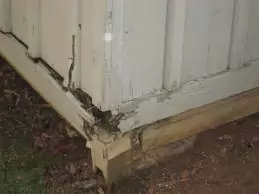If the surface is sound and just has cosmetic damage, you may be able to prep, prime, and paint without replacing anything.
Not Everything Is Wood Rot
Peeling paint and cosmetic issues are often mistaken for rot—but the difference matters.
In Kansas City, we hear it all the time: “I think we’ve got wood rot.” Sometimes that’s true—but often it’s not. Peeling paint, dry caulk, and surface cracking can make siding and trim look worse than they really are.

It’s important to know the difference. Because if it’s just weathered paint, the solution may be simpler than you think.
What Is Wood Rot, Really?
Wood rot is the decay of wood caused by moisture and fungi—and it only happens under the right conditions.
Rot isn’t random. It needs moisture and time. When water sits against wood, especially in shady or poorly ventilated areas, rot can take hold. Once fungus begins to break down the fibers, the wood becomes soft, brittle, or crumbly.
Paint protects wood from rot—but when it fails, water intrusion often follows. Catching it early makes all the difference.
The Age of Your Home Matters
Older homes tend to have better wood; newer homes use softer, faster-growing lumber that’s more vulnerable.
The quality of wood used in home construction has changed dramatically over the last century. If your home was built before 1940, there’s a good chance it has high-quality, old-growth lumber that resists rot better than modern materials.
Homes built after 1960? That’s a different story.
Old-Growth Lumber Holds Up Better
Homes built before 1940 often used denser, more durable wood that resists rot and takes paint beautifully.
In historic neighborhoods like Brookside, Westwood Hills, Old Liberty, and Old Lee’s Summit, homes were typically built using lumber from mature trees. This wood is denser, straighter-grained, and more weather-resistant.
Old-growth wood holds paint better, weathers more gracefully, and repairs more easily. It’s one of the hidden benefits of owning a truly old home.
Fast-Growth Lumber Needs Extra Care
Modern framing and trim use softer wood that breaks down faster and requires careful protection.
As old forests dwindled, builders turned to younger, faster-growing trees. These softer woods—often used in homes built after 1960—are more porous, less durable, and far more prone to moisture damage.
This wood can perform well, but it requires solid paint coverage and good caulking to stay protected. Without those, it can rot in just a few years.
Design Details Can Encourage Rot
Cost-saving construction trends often lead to trim designs and materials that hold moisture and accelerate decay.
Changes in construction materials—like the shift to plywood and composite trim—led to simpler, cheaper design elements. But many of these designs unintentionally create pockets where water collects.
Flat trim, mitered corners, and low overhangs are common culprits. They look clean and modern—but they also trap moisture and block airflow, making wood rot much more likely.
What Wood Rot Looks Like—and Doesn’t
Rotted wood may look swollen, soft, or crumbly—but it’s not the same as peeling paint or surface wear.
Rot is structural. It affects how the wood feels, not just how it looks. If you press on the surface and it gives way easily—or flakes off in chunks—you’re probably looking at decay.
But if the surface is sound and just has cosmetic damage, you may be able to prep, prime, and paint without replacing anything. That’s good news—and a big reason why a proper evaluation matters.
How Crestwood Painting Tackles Rot Repair
From small repairs to major replacements, we know how to assess and address rot before it spreads.
Some firms replace rotted wood with low-grade materials from the big box store. It’s cheap—but not durable. We take a different approach. Where needed, we use naturally rot-resistant cedar or synthetic materials like PVC that are built to last.
We also think through placement and drainage. A good repair doesn’t just patch the damage—it prevents it from coming back.
You’ll also see the difference in the finished product. Our repairs blend in, hold up, and support a longer-lasting paint job—because we’re not just patching, we’re preserving.
Book a Quick Estimate
Not sure if it’s rot or just rough paint? We’re happy to take a look. You can book an estimate online—appointments usually take 30 minutes or less. No pressure, just honest answers and a clear next step.



